I’m afraid my post this morning about the newly green painted lanes on SW Stark and Oak is a bit misleading. The images show just one block face of SW Stark that has a lot of right turns, and the people driving upon the green lanes in the images are preparing to turn right. Like I said, while many of them take liberties with the law and drive in the green lane the entire block, most people do what they should do: merge over onto the green just prior to the turn.
So, why am I doing another post and sharing more photos? Because I want it to be clear that I think the new and improved bike lanes on Stark and Oak are excellent. Even without any physical separation, because they have been made extra-wide (eight feet) and because the new paint is so highly visible (at least so far), the impact on behavior is already noticeable. From what I can tell and from what I’ve heard from others, it is already working very well.
I have been amazed how few people drive on the lanes now that they are fully green. And even Joel Metz, a local bike courier who rides them all the time has noticed a difference. “I rarely see cars on them with the new paint,” he said to me just a few minutes ago. Then he added, “They’re huge!” (as in, the lanes are wide).
Here are more images showing how people in cars seem to be steering clear of them…
This project is likely going to be an important test of how much we can accomplish with paint alone. If PBOT is able to create separation between people on bikes and in cars strictly through visual treatments, they will have done something that requires far less investment and political risk than curbs, bollards, or other types of physical barriers. Of course, if the green is all you’ve got, it must be maintained and it must remain vivid and highly visible or it will lose its power.
It will take more time and analysis to determine if these lanes are working. But so far, so good.

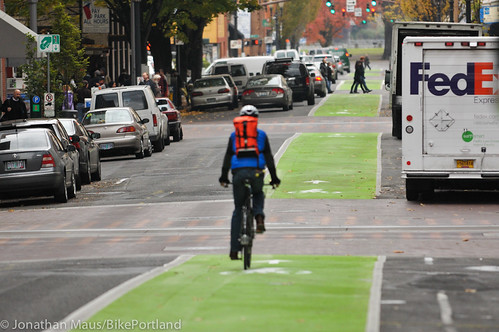

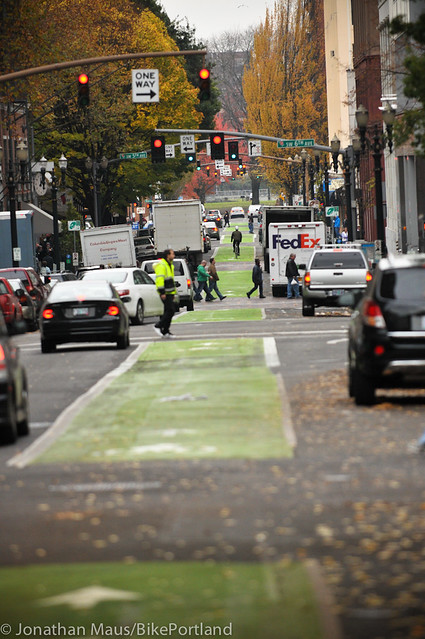
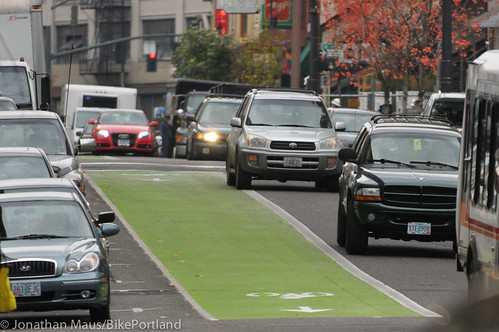
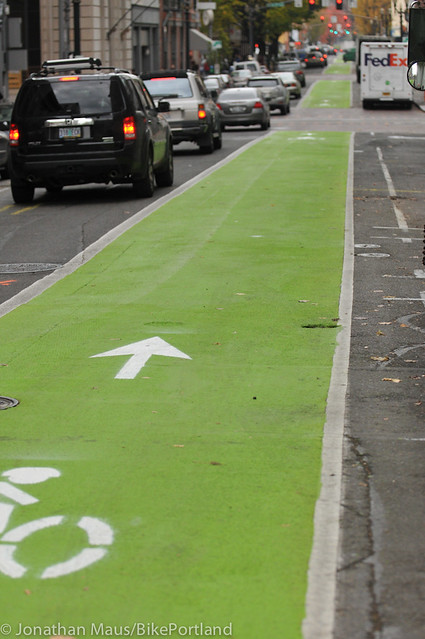
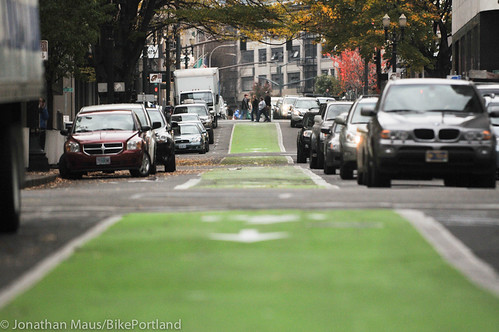
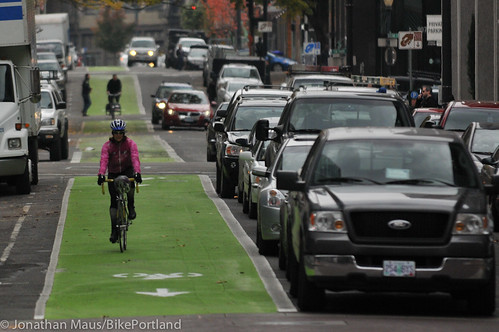


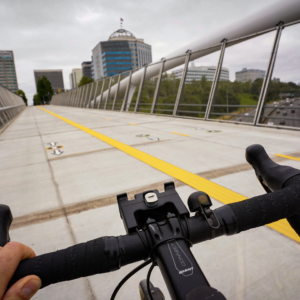


Thanks for reading.
BikePortland has served this community with independent community journalism since 2005. We rely on subscriptions from readers like you to survive. Your financial support is vital in keeping this valuable resource alive and well.
Please subscribe today to strengthen and expand our work.
I need to go check this out in person but I am liking what I see. I think it is helpful that the lane is pretty darn wide! Takes away some of the fear of getting doored by a parked car when you have space within the lane to move around as necessary.
I ride these every weekday and so far the paint does seem to be doing its job of keeping drivers out of there. This was a pretty egregious spot for drivers in the bike lane before (saw several of them every single day driving right down the lane, often with out of state plates) so it’s low hanging fruit.
green is good! we need a no / cars sign in the middle 🙂
it will lose *its* power.
Great job documenting the change, Jonathan! It is great that your office provides the chance to observe the effect this is having on car traffic.
That does actually look like it’s doing the job. I’m excited to try these out shortly. Imagine what this treatment would feel like on Broadway!
BTW, maybe we should all work to have this treatment used on the new Multnomah bikeway instead of the yellow (let’s start setting a precedent!) and paint the lane AND the buffer there too. I rode it last Sunday and while it is nice, it does seem to be rather narrow in some areas (I think the buffer was wider than the lane in a few spots!).
Interesting question about the comparative merits of a buffered bike lane vs. simply widening the bike lane to include the buffer’s width.
At present, on Multnomah, where parking has been introduced between 7th and 9th Ave (and at other spots), the reverse is happening–when parking their autos, people are–almost without exception–including the buffer in their parking spaces:
http://www.flickr.com/photos/81701873@N08/sets/72157632029047800/
Plastic candlesticks were installed today, so I’ll watch to see how that influences the parking behavior; although would I have preferred that they installed those on the buffer edge line, at the markings that define each parking space, instead of almost all the way to the other side of the buffer.
Doesn’t seem to be enough actual space to park without encroaching on the “buffer.” Nice job planners and on site crew!
I got a parking ticket a LONG time ago for my wheel being on the white line of the parking space, technically this is out of the parking space. Seems to me they just need to go through and ticket a bunch of cars, word will get out. Or they need to widen the buffer, and/or move the “candlesticks” over closer to the edge of the buffer. I agree, it looks a bit hazardous.
except that’s not what they should do… they’re not allowed to drive in the lanes at all, not even before getting into to right turn lane…
they’re allowed to CROSS OVER the bike lane during the designated merge area and not before it…
1) truck and van in the green paint…
2) van riding the line
3) suv touching the green…
4) looks all clear!
5) looks all crear!
6) vehicles touching the white line
7) multiple vehicles on the white line
you know how critical we are here and I’d say those are some pretty poor examples of cars steering clear… 29% compliance is not good… if that were another car lane next to them they wouldn’t be riding the line like that…
yes, they may not be fully in the lane traveling the length of the block, but they still don’t respect the space more than the potential ticket cost…
I asked in another comment, how long before the edging gets worn down and cars encroach even further, especially since I’ve started hearing the earliest signals of “crunchy” studded tires unnecessarily driving around downtown this week?
The only problem with those pictures is the lack of bikes! I TRULY believe in “build it and they will come,” but I sure hope they come soon! Then the drivers can make sense of why so much of the road is taken up by green!
I thought the same thing. But many people don’t ride downtown because these type of welcoming facilities don’t exist in more places.
That being said, tons of people use these during commute peak times.
I can attest to this. I typically do not ride through downtown unless I have business. Treatments such of these and the buffered bike lanes on Multnomah St. will definitely encourage a spur route/loop to the bike rides I take some of my less experienced friends on.
I can assure you, as Jonathan said, that those are pretty heavily traveled during rush hour.
Quite a bit of use of them by people on bikes during the lunch hour too.
Like how many, times the two people on bikes over a three block area seen in the pictures, at any given time during lunch or rush hour? Five? Ten? Consistently from day to day during rush and lunch hour, ten to twenty people in the green bike lane in a given block would be fairly impressive. Show us pictures of bike use on the green bike lanes during those times of day, instead of when they’re mostly a barren wasteland.
If the number of people on bikes using the green bike lanes doesn’t increase during lunch hour and rush hour, maybe the green lanes should be open to use by people driving motor vehicles during those hours.
Why don’t you try riding them and find out.
Why don’t you simply answer the question, so that people that may not be able to hang out on Stark and Oak and see first hand how many people on bikes are actually using the green bike lanes, may have your count of how many people are actually riding those lanes?
Because I’m not a traffic engineer and I don’t spend a lot of time (or have the free time for that matter to spend) counting other cyclists.
Offhand, at peak, I’d estimate there are 10-15 cyclists in that lane for its length at any given time. For your edification I’ll take a quick count on the way home tonight and see how it jibes with my estimate. For photo evidence you’ll have to look elsewhere, or at least wait until it isn’t pitch black outside.
well under a thousand a day, according to the 2011 count
http://www.portlandoregon.gov/transportation/article/386265
even assuming there are entirely clumped into a two hour rush, which is not PBoT’s methodology, we would be talking about six or seven per minute at any given point along the route.
on the other, other hand, peak counts for automobiles are only a few hundred, with total volume over 24 hours less than 5k
http://www.portlandmaps.com/detail.cfm?action=Traffic&intersection_id=51413&x=7643407.539&y=683857.931&site_name=SW%20STARK%20ST%20and%20SW%209TH%20AVE&city=PORTLAND&ResultCount=1
so basically, stark and oak are simply less traveled streets, period. somewhere, PBoT may have explained its thinking in using these two streets for this project. it may have been a demo, or it may be something along the lines of the bike boulevard, creating an inviting environment for cyclists to avoid more highly trafficked streets.
i am not downtown very often, but i cannot remember even once using this couplet, partly because if you are coming from the northeast over, say, the broadway bridge, or even burnside, and then eventually back to the northeast, the geometry of these streets is decidedly out of direction. makes more sense to drop down 13th and head back up 12th or 10th, or if you are heading into the southeast, just use madison. so the logic of this couplet has always escaped me.
And it’s November! Look at how much the Hawthorne bridge counts have gone down from a few months ago. Many cyclists are seasonal, this shouldn’t surprise us?
It has been much, much better. It’s even kind of an interesting visual sensation riding on it with all that green pavement streaming by under you.
I do note, both personally and in most of the photos above, that there is usually a car straddling the white line or even into the green with their right tires and will do so for the entire length (note the white van in multiple pictures above). I wonder how quick the edges of the lane will wear out (especially during “stud” season). If the edges get worn out, will it encourage cars to just encroach more?
Just look at all those people on bikes in the green bike lanes! One picture shows, over a series of three blocks, a total of two people on bikes, one per block, separated by a block! I hope they were able to avoid colliding with each other. Meanwhile, the pictures show cars backed up in the main lanes of travel.
So I’m curious Bob, do you actually ride a bike, and/or care about bikes? You say you do, but it seems that all you do is come on here to stir the pot.
Jonathan also chose a random time of day on a November weekday. Not exactly prime riding time anywhere.
What I think is important to do, is ask questions that should be asked, that other people may not have thought about, or for some reason, aren’t willing to ask. In response to today’s bikeportland stories about the Stark/Oak bike lanes, people commenting posted one after another with the exception of one, about how great the bike lanes were, without seeming to question the fact that the pictures showed almost no people on bikes in the bike lanes.
Maybe you don’t think it’s any big deal that very few people appear to be using areas of the road the city has spent a fair amount of the public’s money in creating bike specific use for that area of the road, but I think it’s a good bet that many people in Portland are definitely thinking this use of the public’s money is a very big deal, and not necessarily a good one.
In fact, that spending money on this kind of project seems to be seen by some Portland taxpayers as a dubious expenditure, probably is part of what was able to propel KATU’s story from earlier this week, in which the station speculated and presumed about what mayor-elect was preparing to do with the city’s transportation budget with regard to spending on bike infrastructure.
At any rate, I made the comment about number of bikes in the bike lanes, with an exclamation point…thinking people would kind of laugh about it, and maybe think some more about what actual level of use is going on in the bike specific green lanes.
I agree that it’s important that people ask these questions, and I agree it’s unfortunate that Jonathan chose to take the pictures at a low usage time. One would hope that any real action on the matter would be done so using hard data instead of anecdotal photos, but obviously that’s not how the world always works.
Many of us didn’t choose to question whether or not the lanes were great and/or useful and/or warranted because we actually ride them all the time and see firsthand how often they’re used. I’d love to see real data behind their usage as much as you would, but as a daily user of them, frequently riding beside three or four other cyclists at any given block stretch, I have much lower doubt as to their justification.
Tonight I had to leave work a bit early. I left from 9th and Stark and rode down to Naito. On the way I counted 7 cyclists total, including myself. However, 4:45PM is hardly peak time, and given that I could only scan about half the bike lane at any given time, among other things, stunningly unscientific.
Either way, this brings up an interesting conundrum. You don’t seem to want to take the word of people who ride this every day who say that it actually has good ridership, in which case my unscientific data won’t make a lick of difference to you. Thus you’re basically telling us that we’re full of it, in which case you’re being an ass.
The other possibility is that you know full well that the lanes are well used, and are simply trying to make a point about the photos make it appear otherwise. In this case you should know better than to harp on about photos since they are completely anecdotal, in which case you are being an ass.
So when it comes down to it, which kind are you being?
“…Either way, this brings up an interesting conundrum. You don’t seem to want to take the word of people who ride this every day who say that it actually has good ridership, in which case my unscientific data won’t make a lick of difference to you. Thus you’re basically telling us that we’re full of it, in which case you’re being an ass. …” Dolan Halbrook
Hey…I’m looking at the pictures and remarking on what can be seen in them…and that’s it. A little ribbing perhaps, but nothing that would seem disrespectful or insulting to anyone except those that have a very thin skin.
Anyone could look at the pictures and make the same observation I have. Your first hand count of 7 people riding at 4:45PM may not be far off from the number of people that were riding Stark at the time Jonathan snapped his pictures, a time by the way, not posted to his story.
Peak commute time for this part of town is probably 7am-9am, 4pm-6pm. Actually being there observing, it would probably become readily apparent what times during those hours, street use was the highest. Pictures taken during peak use or commute times would be interesting to see.
Geez. What is the amount of bike traffic you’d like to see on this stretch during the one random time that Jonathan took the picture. I live on a street that rarely has any car traffic on it–in fact right now there is not a single car to be seen….but I don’t expect PBOT to come and remove the street or not fix it when it is broken just because there is an anecdotal moment when the road is functioning at less than capacity. By your standard we should pull the freeways–I saw one last night at about 1:15 that was almost empty…..
“…Geez. What is the amount of bike traffic you’d like to see on this stretch during the one random time that Jonathan took the picture. …” Jeremy Cohen
Better question: ‘What numbers of people on bikes might be expected on Stark and Oak between during am and pm commute hours, and other times of the day?’.
I would have hoped Maus would have posted pictures taken during peak bike traffic moments. The story I would liked to have read here, is about how effective the green pavement bike lane treatment was in inviting people that bike to use these specially prepared bike lanes.
A few pictures showing 10-20 people on bikes on the green bike lane at one time, over a two to three block section of the street would have been great, if of course, somewhat consistently during commute times or otherwise, there ever is somewhere around that number of people on bikes using the street.
By the way…sure, I ride, but not in Portland much anymore, because I live out in the Beav, and I’m not feeling the need to be as fit as I once did. It’s been awhile, but I’ve ridden Portland’s streets quite a lot, so I’m fairly familiar with Downtown, NW, SE, East Broadway.
For most people, today’s weather shouldn’t be bad for riding…not too cold, not raining. For sure, it’s kind of dark and gloomy. Basically though, I don’t believe the type of weather we had today would scare off riders with a modest level of experience and conditioning. If people traveling by bike that needed to use Stark and Oak outside of lunch and outside of peak commute times existed, I would have expected that Maus would have had them in his camera viewfinder.
I worked downtown for 10 years and commuted by bike for 6 of those years, I’ve never understood the need for additional facilities on downtwon streets. Sure, the bike lane up Broadway makes sense because of the degree of the incline, but otherwise the lights downtown are timed at a bit under 12mph, I have NEVER had a problem keeping up with the speed of traffic, and have felt perfectly safe by putting myself right in the middle of the lane and travelling at the speed of auto traffic. I’d argue the lack of use of these bike lanes is because it’s easier to bike on Alder/Washington as you come from (or go to) the east side.
Surely you don’t mean to imply that bicycling on Washington Street coming from the Eastside (which means that you would have had to have biked over the Morrison Bridge in the general traffic lanes) is “easy”, or even safe. I’ve seen people do this on occasion and they honestly have a death wish.
And while Alder/Washington provide more connections in Downtown than Stark/Oak do (on account of them travelling further west in the street grid), they are always more crowded and unpleasant to ride than parallel streets precisely because of the I-5/I-84 traffic that is dumped on the Morrison in the morning and the reverse travel in the evening. Stark and Oak have the dedicated lane, of course, but are also more lightly traveled (which makes the green lanes superfluous IMO).
What are you scared of? Traffic moves at no more than 12mph because of the timing of the lights, that’s an easy speed to maintain so you just move along with the flow of traffic. So long as you put yourself right in the middle of the lane (so there’s no danger of getting doored and no danger of someone trying to squeeze past you) there’s less danger than riding in a bike lane where you have to watch out for right hooks and doors.
On the Morrison Bridge??? Try 35-50 mph. Reread what I wrote. There is no easy way to get from the Bridge path to Washington Street so I’m assuming you’re taking the lane on Morrison Street across the bridge past the I-5 ramps.
I have no problem taking the lane in Downtown and very frequently do so even when there’s a bike lane (like the Broadway door zone bike lane).
Try biking up to PSU sometime from the Hawthorne bridge.
Tonight I drive my car down Stark and what I really like is the clearer guidance on how to turn right onto 3rd. The bike lane changes pattern where I can merge across and there is a right turn only lane to the right of the bike lane that used to be parking. This is great. I’m heartened by the effort the city is putting into trying new solutions here.
I think Mr. Maus might have been trying to illustrate how empty the green lane is EVEN WHEN NO BIKES are in it. Exemplifying a degree of respect for the space that might not have been there before. The stark (!) contrast helps that point being made.
I have lived between The Netherlands and Portland over the last 4 1/2 years and I can tell say that even in Europe, during certain times of the day, the bike lanes have very few people in them.
Come back at a peak time and you can barely get into some of the bike lanes without accidentally hitting someone else.
Portland doesn’t have anywhere near the bike-ridership as cities in The Netherlands (obviously), but like in The Netherlands, there are times of the day when there are more people out on their bikes than at other times.
These images were obviously taken at a time when there were less people out of their bikes and means very little in the context of things.
–Roads aren’t always packed with vehicular traffic either.
“… These images were obviously taken at a time when there were less people out of their bikes and means very little in the context of things. …” Toon
The context, or a significant part of it evident in the pictures, is a street consisting of a main travel lane and a full lane width bike lane: the main travel lane is filled with cars…the bike lane has very few people riding in it.
Maybe I said it wrong, please excuse my English skills. I think I might have said instead “bigger picture” ? But I am not sure how to say it.
The phrases, ‘bigger picture’, and ‘the context of things’ do, I think, raise different questions about designation of these particular bike lane treatments on these particular streets, and how they’re being used by people riding bikes.
Certainly, in the bigger picture of things, drawing from a wide range of treatments used towards encouraging biking on the part of people that might not otherwise be inclined to bike, can have plenty of merit. If the extra effort made by the use of the green paint to keep motor vehicles from entering and occupying the bike lanes does truly bring more people on bikes to use these particular bike lanes, that would be a great thing.
One key question then, is whether the green paint is having any such effect whatsoever; that is, whether the paint, and the comparative safety and comfort to be had in using these particular bike lanes over other nearby bike lanes not similarly treated, is attracting more people in the area riding bikes, to use these bike lanes.
By the way…your English skills seem to be good.
I just moved to socal after living in portland for 17 years it sucks here. there some bike lanes, but people like to park in them and the speed limits are crazy fast. I need some advice on how to get something going down in these parts, I’m miss you Portland, your spoiled, and I love you.
Those photos remind me of how Judge Zusman must envision bike lanes.
Regarding all the comments about apparent lack of usage:
1. There is very little that can be inferred from a single set of photos taken within a short amount of time.
2. “If you build it they will come” has to be understood to include a bit of a time delta between building and coming–and with the previous treatment of this bike lane, it should be considered to have just been built.
3. As ‘are’ alludes to in a post above, there is such a thing as brilliant infrastructure in a crappy location. This street is apparently not used very much by car drivers either, which is probably why it was chosen for a bike treatment. Drivers don’t want it very much, so we’ll let the bike people “have” it. The unasked question I think of (wsbob) is “why is this street underused by autos?” Is it not a major connector between popular destinations? Is it not well-connected to river crossings? If it isn’t well-used by autos, what made anyone think it would be useful as a bike route? Does green paint smell like donuts? Is it irresistible to cyclists?
I think there is a particular phenomenon that is possible when building bike infrastructure: Transpo authorities look for a place to put something–anything–to make it look like they like bikes. Unfortunately, those authorities are under some amount of pressure not to “take away” road space from cars, so they look for either locations that are “out of the way”, or treatments that don’t result in much loss of car driving space. Then a facility is implemented that is either a) too complicated, b) too dangerous to be used with any frequency, or c) a beautiful “bike lane to nowhere” that no one uses because it doesn’t connect any desirable destinations. Then “news” outlets and the general public and government officials can point out all the money that was spent and the traffic that was disrupted, and the travel lanes or parking spaces lost, and the confusion that was introduced and “show” how spending on such things is a waste of money “because nobody even uses it”.
“…This street is apparently not used very much by car drivers either, which is probably why it was chosen for a bike treatment. …” El Biciclero
The pictures show the main travel lanes, or…I guess it’s actually, ‘lane’…filled with cars. It does seem to be true that Oak and Stark generally are used less by people driving than say, Main, Jefferson, Taylor, but I don’t think ‘not used very much by car drivers’ is accurate.
The Oak/Stark bike lane experiment has been going on for some time now. Not stopping at the moment to check, but I think it’s been a year or more. I’m sure someone will be monitoring these particular green bike lanes to determine various things, among them…whether more people begin to ride them compared to last year, as the months go on. At least, I hope they’ll be monitored for bike use counts.
In discussions about Oak/Stark from last year, quite a number of people commented about the ease and safety they’d had using the streets on bikes, pre-bike lane. The two main lane configuration helped to enable that relatively safe use of the streets by both bike and motor vehicle users. I don’t recall whether there were or weren’t close calls or collisions that led to installation of the bike lanes.
the pictures are exactly as anecdotal with respect to cars as they are with respect to bikes. the formal traffic counts
http://www.portlandmaps.com/detail.cfm?action=Traffic&intersection_id=51413&x=7643407.539&y=683857.931&site_name=SW%20STARK%20ST%20and%20SW%209TH%20AVE&city=PORTLAND&ResultCount=1
show peak counts for automobiles at only a few hundred per hour, with total volume over 24 hours at less than 5k
OK: “As a driving route, it is apparently not used as much as other driving routes.”
Better?
I guess part of my point from above was why spend money and restrict a lane on a street that doesn’t really need that kind of treatment to “protect” cyclists? In my mind, this specific project (not bike infrastructure projects in general) could easily be pointed to as a waste of money since the street gets relatively little car traffic and the speed limit is (I assume, if this is a business district) 20 or less–probably “less” with lights and such–and there really doesn’t seem to have been a need for much “protection”. Spending money and restricting lanes on a street like this seems to serve more to generate negative reactions than to provide any real safety for cyclists.
I have mixed feelings about constructing bike lanes like this–or even like the new “separated” bike lanes on Multnomah–as a ploy to entice novice riders out onto their bikes. Unless the infrastructure is completely off-grid (e.g., Springwater trail, US 26 MUP, etc.), there is nothing we can build that will absolve riders of the requirement to pay attention to car traffic, learn driver behavior patterns, know how to take evasive action, signal intentions, negotiate with other road users, etc.–anyone who thinks otherwise is itchin’ for a bad experience. If such skills are needed and learned riding within specific infrastructure, they can just as easily be applied to riding without specific infrastructure–often to greater effect. The problem is that too many don’t feel comfortable learning or applying the exact same skills in a setting that “feels” more dangerous, even though it might actually be safer. Maybe the real value of infrastructure is that it serves as “training wheels” of sorts to learn traffic skills that could then be applied outside of infrastructure, if that were legal.
All of this is not to say that well-placed, well-designed infrastructure can’t be useful, but it sure seems as though most of what happens around here is lacking in one or both of those attributes. I may have to give up and face the fact that most road users are irrational, and D’s of T tend to pander to that.
“I guess part of my point from above was why spend money and restrict a lane on a street that doesn’t really need that kind of treatment to “protect” cyclists? …” El Biciclero
Exactly. In stories from around a year ago about the Stark/Oak bike lane treatment, more people commented, relating their familiarity with relative safety and ease of use of the street on bikes and expressing their doubt as to whether the treatment was needed on this street at all.
There are questions that the Stark/Oak bike lane treatment raises, that attempts ought to be made to answer.
If for example, the green, nearly full lane bike lane treatment had ushered onto the street, substantial numbers of people on bikes that hadn’t been riding the street before, that increase could possibly answer ‘yes’ to the question of whether the bike lane treatment actually is regarded by people that bike as significant, practical support for biking as a mode of urban transportation.
this was announced in 2009 as a demonstration project, concurrent with the cycletrack down by PSU, “to see which of the two work[s] better.”
http://www.portlandoregon.gov/transportation/50346
the press kit stated these streets were selected because they had “light traffic flows,” so that closing a lane would not significantly impact motor traffic, and that the “principal advantage” of the design was to create a “more protected and comfortable space” for cyclists
http://www.portlandoregon.gov/transportation/article/262801
this language, plus the emphasis on the fact that stark and oak connect to the waterfront park and are “near other major bicycle commuting routes” [which is not the same as “connected to”] strongly suggests that the idea was to encourage at least some cyclists to choose this route over more direct alternatives. unfortunately, we cannot have data on whether this treatment actually increased bike traffic here, because PBoT was not counting stark until 2009 and they apparently did not get data for 2010.
I work in the area and have seen cars driving directly down the bike lane for blocks at a time, seemingly clueless about what they are doing. While I think this helps, it certainly hasn’t stopped everyone.